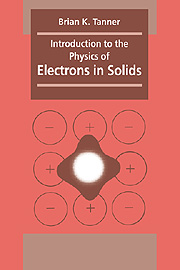Book contents
- Frontmatter
- Contents
- Preface
- Acknowledgements
- 1 The classical free electron model
- 2 Quantum mechanical free electron model
- 3 Application of the Fermi gas model
- 4 Energy bands
- 5 Experimental evidence for band structure and effective mass
- 6 Electrical conduction in semiconductors and insulators
- 7 Semiconductor devices
- 8 Localized electrons
- 9 Magnetism
- 10 Superconductivity
- Appendix 1 Elements of kinetic theory
- Appendix 2 Elements of statistical mechanics
- Appendix 3 Derivation of the Landé g factor
- Index
- Frontmatter
- Contents
- Preface
- Acknowledgements
- 1 The classical free electron model
- 2 Quantum mechanical free electron model
- 3 Application of the Fermi gas model
- 4 Energy bands
- 5 Experimental evidence for band structure and effective mass
- 6 Electrical conduction in semiconductors and insulators
- 7 Semiconductor devices
- 8 Localized electrons
- 9 Magnetism
- 10 Superconductivity
- Appendix 1 Elements of kinetic theory
- Appendix 2 Elements of statistical mechanics
- Appendix 3 Derivation of the Landé g factor
- Index
Summary
Probably the most spectacular phenomenon associated with the breakdown of the independent electron approximation is that of superconductivity. In the superconducting state, the material loses all resistivity and becomes a perfect conductor. The discovery in 1986 of oxide materials which were superconducting at temperatures above that of the boiling point of nitrogen sparked an unprecedented surge of activity in the field which remains an area of high profile and popular interest.
The discovery of superconductivity
In 1908 Kammerlingh Onnes succeeded in liquefying helium and set about the task of studying the properties of metals at these extremely low temperatures. As we saw in Chapter 1, the resistivity of metals such as platinum fell to a small, non-zero value when extrapolated to T = 0. This residual resistivity fell with improvements in purity and thus Onnes studied mercury, which was the most pure metal available at that time. To the great surprise of Onnes and the whole scientific community, the resistivity fell monotonically until just above the boiling point of helium and then fell abruptly to zero. Fig. 10.1 shows an example of the superconducting phase transition in yttrium barium copper oxide, one of the high temperature superconducting oxides. Onnes was unable to measure precisely the transition width or whether the resistivity was genuinely zero. However, in 1963 File and Mills measured the decay of a persistent current set up in a superconducting ring using nuclear magnetic resonance as the probe.
- Type
- Chapter
- Information
- Introduction to the Physics of Electrons in Solids , pp. 213 - 236Publisher: Cambridge University PressPrint publication year: 1995



